Writing a clear and compelling mission statement can be the difference between success and obscurity.
A mission statement is more than just a string of words; it encapsulates the essence of your organization, guiding your strategic decisions and inspiring your team.
It serves as a beacon, illuminating the path toward your company’s goals and values.
But what makes a mission statement truly effective? Without sounding like corporate mumbo jumbo?
In this article, we will dive into what a mission statement is, why it’s important, and we’ll provide a ton of great mission statement examples for you to use for inspiration.
These mission statement examples showcase how leading companies articulate their purpose and drive their success.
At the end, we’ll also provide a free mission statement template to help you create or refine your own!
What is a Mission Statement?
A mission statement is a concise declaration of an organization’s core purpose and focus.
It’s a key component of a company’s identity, serving as a guiding principle for all business activities and decision-making processes.
At its core, an effective mission statement typically addresses:
- The company’s primary function or offering
- The target audience or beneficiaries
- How the company delivers its products or services
- The underlying values or motivations driving the business
For example, consider Tesla’s mission statement:
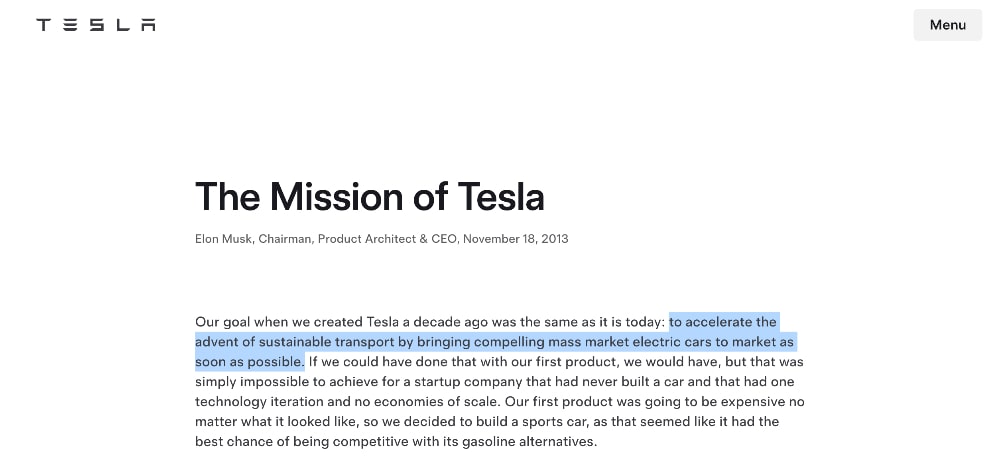
“To accelerate the advent of sustainable transport by bringing compelling mass market electric cars to market as soon as possible.”
This comprehensive statement includes Tesla’s:
- Purpose (accelerating sustainable transport),
- Target (mass market),
- Offering (compelling electric cars),
- and its underlying Motivation (urgency in bringing these vehicles to market).
Unlike a vision statement, which outlines long-term aspirations, a mission statement focuses on the present.
It articulates the company’s current purpose and how it aims to serve its stakeholders.
Why Are Mission Statements Important?
The importance of a well-crafted mission statement cannot be overstated.
It serves multiple crucial functions:
- Provides direction and focus for the organization
- Aligns employees around a common purpose
- Informs strategic planning and decision-making
- Communicates the company’s value proposition to customers and stakeholders
- Differentiates the organization from competitors
It’s worth noting that while a mission statement should be enduring, it’s not necessarily permanent.
As companies evolve and adapt to changing markets, their mission statements may need to be revisited and refined to ensure they remain relevant and accurate.
In the following sections, we’ll explore numerous examples of mission statements from various industries, analyzing what makes them effective and how they contribute to each company’s success.
What Makes an Effective Mission Statement?
Below are some of the key elements that make a mission statement truly effective, but keep in mind that you don’t have to have ALL of these elements to have a good mission statement.
They serve as more of a guideline for good elements to include:
- Clarity and Conciseness: A good mission statement is clear, concise, and easy to understand. It should be brief, ideally under 100 words, and use direct language that quickly conveys the company’s purpose.
- Specificity: The statement should be specific to your organization. If it could apply to any company, especially competitors, it’s not distinctive enough.
- Action-Oriented: Use strong action verbs to describe what your company does. This creates a sense of purpose and direction.
- Stakeholder Focus: An effective mission statement speaks to key stakeholders, particularly customers and employees. It should describe the relationships the organization wants to have with these groups.
- Inspirational and Aspirational: While grounded in the present, a good mission statement should also be somewhat aspirational, inspiring both employees and customers.
- Alignment with Core Values: The mission statement should reflect the organization’s core values and personality.
- Memorable: A great mission statement is easy to remember. This helps it stick in the minds of employees and customers alike.
- Longevity: While mission statements can evolve, they should be designed to endure over time, providing consistent guidance for the organization.
- Actionable: The statement should provide a clear guide for decision-making within the organization.
- Unique: It should differentiate your organization from others in your industry.
For example, consider Patagonia’s mission statement:
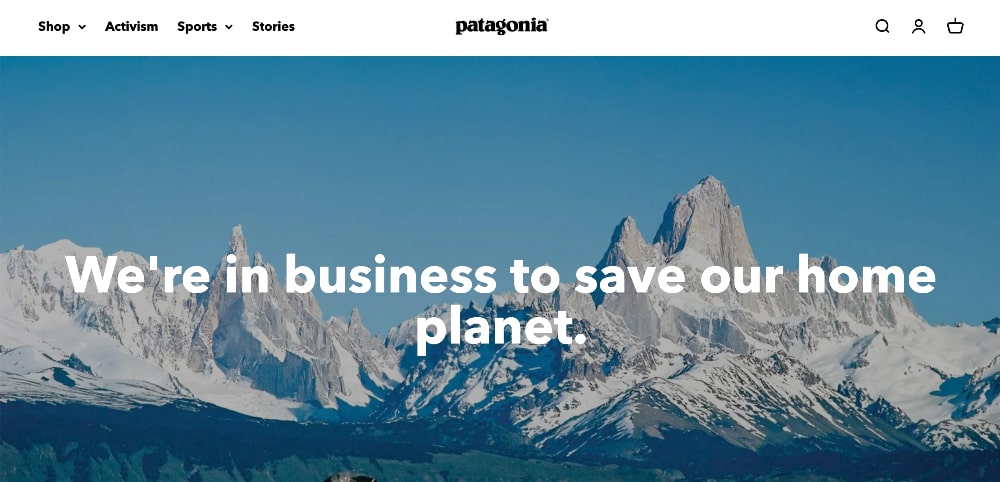
“We’re in business to save our home planet. At Patagonia, we appreciate that all life on earth is under threat of extinction. We aim to use the resources we have—our business, our investments, our voice and our imaginations—to do something about it.”
This mission statement is concise, action-oriented, inspirational, memorable, and unique.
Again, your mission statement doesn’t have to include every single one of these key elements, but you can use them as a guideline when writing your own mission statement.
46 Effective Mission Statement Examples
These successful mission statement examples can provide valuable inspiration for crafting your own.
Here’s a diverse collection of effective mission statements from various industries:
Technology Companies

- Google: “To organize the world’s information and make it universally accessible and useful.”
- Microsoft: “To empower every person and every organization on the planet to achieve more.”
- Apple: “To bring the best personal computing experience to students, educators, creative professionals, and consumers around the world through its innovative hardware, software, and internet offerings.”
- Amazon: “To be Earth’s most customer-centric company, where customers can find and discover anything they might want to buy online.”
- Facebook: “To give people the power to build community and bring the world closer together.”
- IBM: “To be the world’s most successful and important information technology company.”
Retail and E-commerce
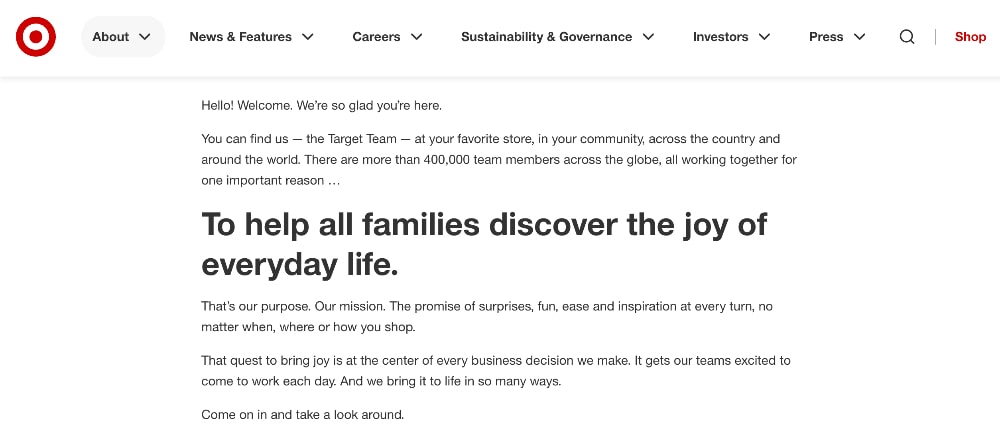
- Target: “To help all families discover the joy of everyday life.”
- Walmart: “We save people money so they can live better.”
- Etsy: “To keep human connection at the heart of commerce.”
- eBay: “To make selling and buying equitable, attainable, and sustainable.”
- Zappos: “To live and deliver WOW.”
- IKEA: “To create a better everyday life for the many people.”
Food and Beverage
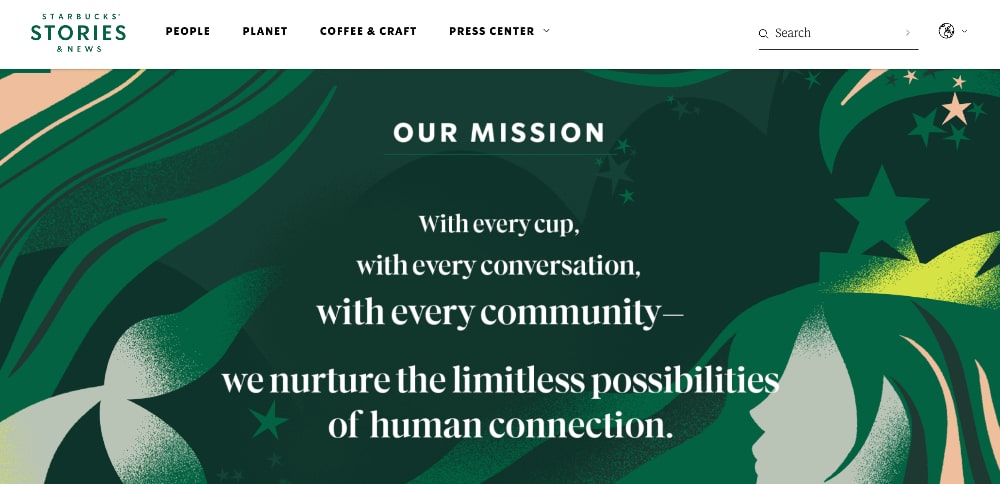
- Starbucks: “To nurture the limitless possibilities of human connection—with every cup, with every conversion, with every community.”
- Coca-Cola: “To refresh the world in mind, body, and spirit.”
- McDonald’s: “To make delicious feel-good moments easy for everyone.”
- Whole Foods: “To nourish people and the planet.”
- PepsiCo: “Create more smiles with every sip and every bite.”
Healthcare and Pharmaceuticals
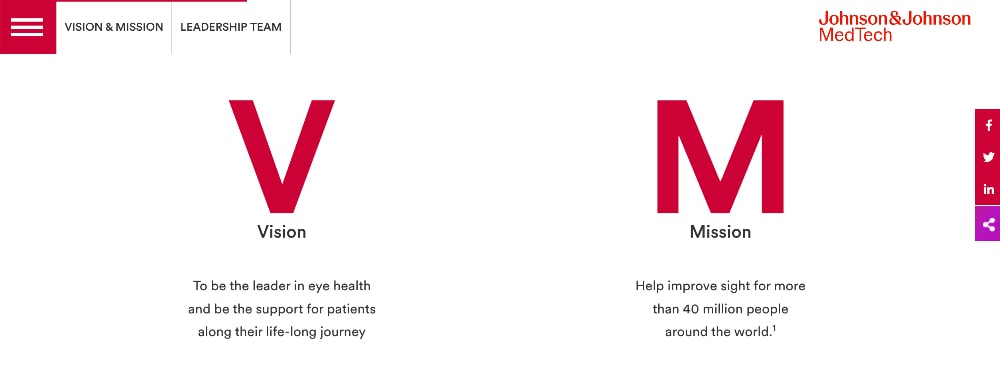
- Johnson & Johnson: “Help improve sight for more than 40 million people around the world.”
- Mayo Clinic: “To inspire hope and promote through integrated clinical practice, education, and research.”
- Pfizer: “Breakthroughs that change patients’ lives.”
- Cleveland Clinic: “Caring for life, researching for health, educating those who serve.”
- Merck: “We use the power of leading-edge science to save and improve lives around the world.”
Financial Services

- Visa: ” To uplift everyone, everywhere by being the best way to pay and be paid.”
- JPMorgan Chase: “To provide the highest quality service to millions of consumers, small businesses and corporate, institutional, and government clients in the U.S. and around the world.”
- American Express: “Become essential to our customers by providing differentiated products and services to help them achieve their aspirations.”
- Goldman Sachs: “To be the world’s most exceptional financial institution, united by our shared values of partnership, client service, integrity, and excellence.”
- PayPal: “To revolutionize commerce globally.”
Automotive
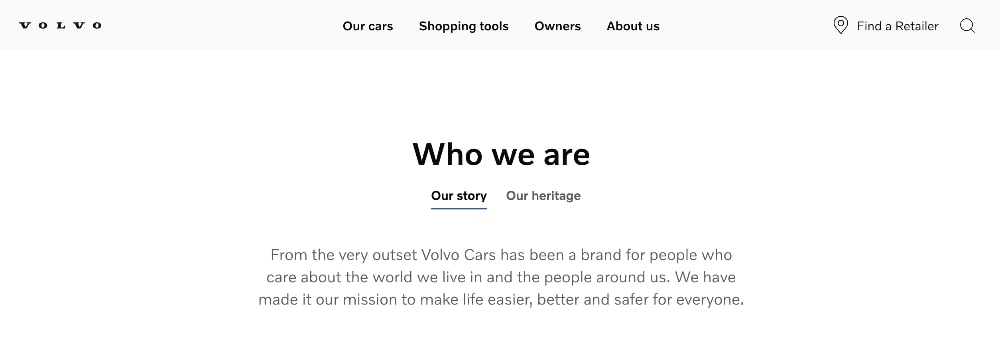
- Volvo: “To make life easier, better, and safer for everyone.”
- Toyota: “To lead the future mobility society, enriching lives around the world with the safest and most responsible ways of moving people.”
- Honda: “To create intelligent products that enhance mobility and increase the joy in people’s lives.”
- Ford: “To help build a better world, where every person is free to move and pursue their dreams.”
Entertainment and Media

- Disney: “To entertain, inform, and inspire people around the globe through the power of unparalleled storytelling, reflecting the iconic brands, creative minds, and innovative technologies that make ours the world’s premier entertainment company.”
- Netflix: “To entertain the world, thrilling audiences everywhere.”
- Spotify: “To unlock the potential of human creativity by giving a million creative artists the opportunity to live off their art and billions of fans the opportunity to enjoy and be inspired by it.”
- The New York Times: “To help people understand the world through on-the-ground, expert, and deeply reported independent journalism.”
Education

- Khan Academy: “To provide a free, world-class education for anyone, anywhere.”
- Harvard University: “To educate future leaders is woven throughout the Harvard College experience, inspiring every member of our community to strive toward a more just, fair, and promising world.”
- Coursera: “To bring flexible, affordable, job-relevant online learning to individuals and organizations worldwide.”
- Teach for America:” To find, develop, and support equity-oriented leaders to transform education and expand opportunity for all children.”
Non-Profit Organizations
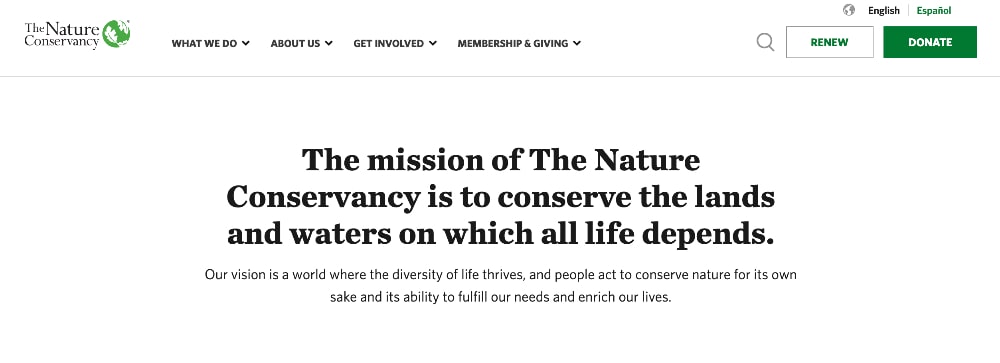
- The Nature Conservancy: “To conserve the lands and waters on which all life depends.”
- American Red Cross: “To prevent and alleviate human suffering in the face of emergencies by mobilizing the power of volunteers and the generosity of donors.”
- World Wildlife Fund: “To conserve nature and reduce the most pressing threats to the diversity of life on Earth.”
- UNICEF (United Nations Children’s Fund): “To advocate for the protection of children’s rights, to help meet their basic needs, and to expand their opportunities to reach their full potential.”
Travel and Hospitality
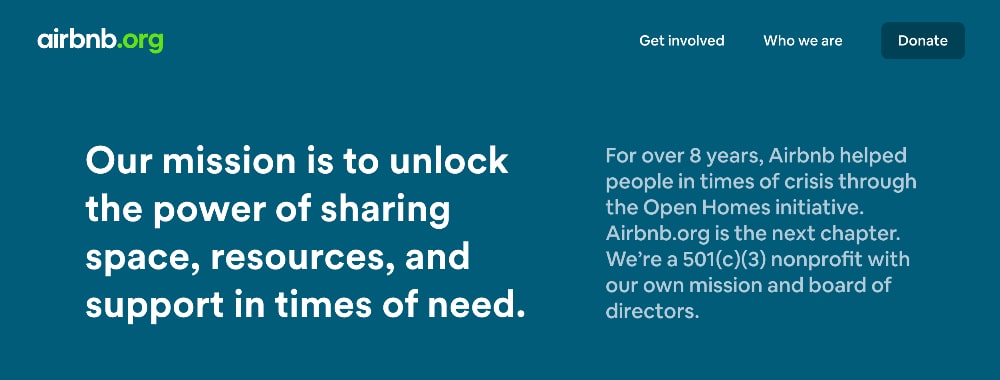
- Airbnb: “To unlock the power of sharing space, resources, and support in times of need.”
- Booking.com: “To make it easier for everyone to experience the world.”
- Delta: “To connect people to opportunities while expanding the understanding of our planet and the people within it.”
How to Write a Mission Statement
Crafting an effective mission statement is a crucial step in defining your organization’s purpose and direction.
Here’s a step-by-step guide to help you create a compelling mission statement.
1. Reflect on Your Core Purpose
This crucial first step involves deep introspection about your organization’s fundamental reason for existence. Take time to consider and discuss the following key questions:
- Why does your company exist?
Go beyond surface-level answers like “to make money.” Dig deeper into the value you provide to society or your industry.
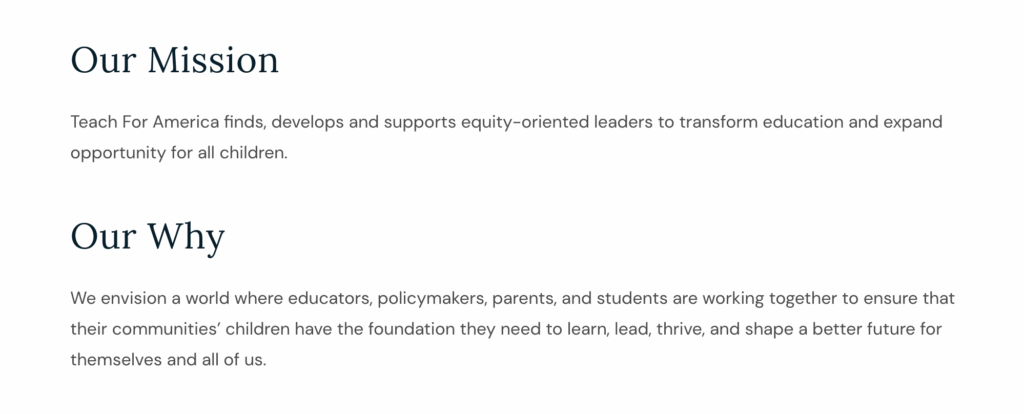
- What problem are you solving for your customers?
Identify the specific pain points or needs your products or services address. How do you make your customers’ lives better or easier?
- What makes your approach unique?
Consider your company’s special strengths, innovative methods, or distinctive philosophy that sets you apart from competitors.
- What impact do you want to have on the world?
Think about the broader influence your organization aims to have, whether it’s in your local community or on a global scale.
- What are your company’s core values?
Identify the principles that guide your decision-making and shape your company culture.
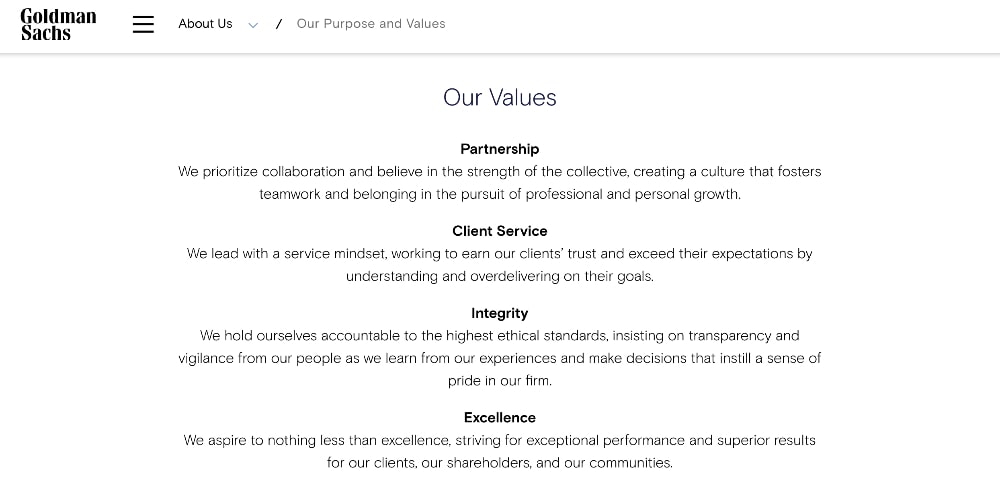
- Who benefits from your work?
Consider all stakeholders, including customers, employees, partners, and the wider community.
Remember, this reflection should capture the essence of why your organization exists beyond just making a profit.
It’s about identifying your company’s unique contribution to the world and the driving force behind your work.
This core purpose will serve as the foundation for your mission statement, ensuring it’s authentic, meaningful, and truly representative of your organization.
2. Identify Your Key Stakeholders
Identifying your key stakeholders is crucial because it ensures your mission statement resonates with all groups essential to your organization’s success.
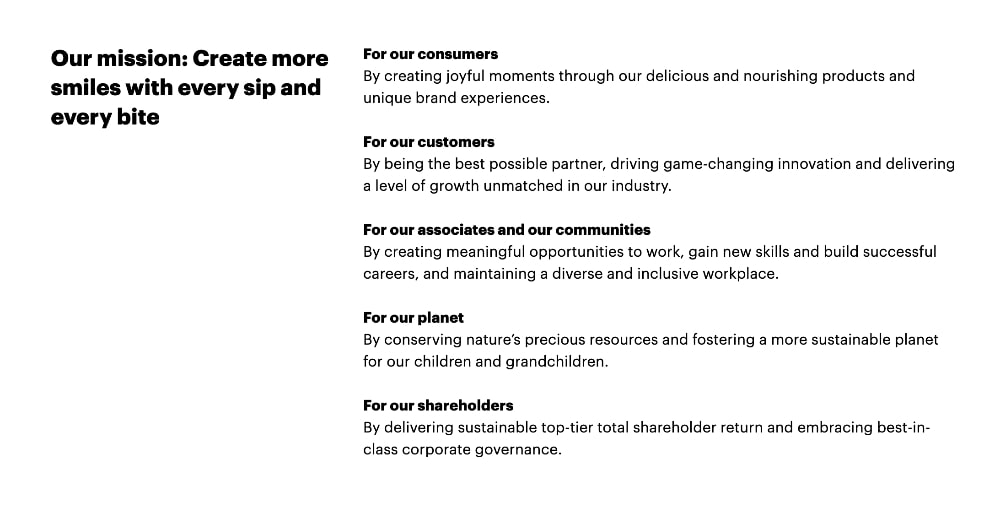
By understanding and addressing the needs and expectations of various stakeholders, you create a mission that not only guides your company’s actions but also fosters buy-in and support from customers, employees, investors, and the community.
This alignment between your mission and stakeholder interests can lead to stronger relationships, increased loyalty, and ultimately, greater organizational success.
Consider who your mission statement needs to resonate with:
- Customers: Who buys your products or services? What are their needs, values, and expectations? How does your mission align with their goals?
- Employees: Who works for your organization? How does your mission inspire and guide them? What role do they play in fulfilling the mission?
- Investors: Who provides financial backing? How does your mission align with their investment goals and values? How does it demonstrate potential for growth and impact?
- Partners: Who do you collaborate with? How does your mission complement their objectives? How can it strengthen these relationships?
- Community: What broader groups are affected by your work? This could include local communities, industry groups, or even global populations. How does your mission contribute to their well-being?
Remember, a strong mission statement should help each group understand how they fit into your organization’s broader goals and values, fostering a sense of connection and shared purpose.
3. Define Your Value Proposition
A clear value proposition is the cornerstone of an effective mission statement. It’s the unique promise of value that your organization delivers to its customers and stakeholders.
To define your value proposition, ask yourself:
“What do we offer that is truly unique and valuable?”

Consider the problems you solve, the needs you meet, and how you do it differently or better than others. This isn’t just about your products or services, but about the overall experience and impact you create.
Examine your organization from multiple angles:
- Customer perspective: What benefits do they receive?
- Market perspective: How do you stand out from competitors?
- Internal perspective: What special capabilities or approaches do you possess?
Your value proposition should be specific, measurable, and meaningful to your target audience. It should reflect not just what you do, but why it matters.
A strong value proposition also isn’t created in isolation. Engage with your customers, employees, and other stakeholders to understand their perceptions of your value.
Their insights can help you articulate a proposition that resonates authentically with your audience and aligns with your organizational purpose.
4. Draft Your Statement
Now that you’ve reflected on your purpose, identified stakeholders, and defined your value proposition, it’s time to craft your mission statement.
This is where you distill all your insights into a clear, concise, and powerful declaration.
Start with a strong action verb that captures the essence of what you do. For example, “empower,” “transform,” or “innovate.” This sets a dynamic tone for your statement.
Keep your statement brief and to the point. Aim for one to three sentences or about 20-100 words. Remember, a concise statement is more likely to be remembered and repeated.
Make sure that your draft includes:
- Your core purpose
- Who you serve
- What you offer
- How you’re unique
Avoid jargon or overly complex language. Your mission statement should be easily understood by anyone who reads it, from employees to customers to the general public.
Don’t worry about perfection at this stage. Write several versions, experimenting with different phrasings and emphases. You can refine and polish in the next steps.
You can also use an AI tool like Claude to help you write your mission statement. Just make sure to give it as much relevant information and context as possible so that it provide good outputs.
5. Review and Refine
Once you have a draft of your mission statement, it’s time to critically evaluate and polish it.
Start by reviewing your draft against these key criteria:
- Clarity: Is the statement easy to understand at first reading?
- Inspiration: Does it motivate and energize your team and stakeholders?
- Authenticity: Does it genuinely reflect your organization’s values and culture?
- Distinctiveness: Could this statement apply to any other organization, or is it uniquely yours?
- Longevity: Will this statement remain relevant as your organization grows and evolves?
Take time to reflect on each word and phrase. Ask yourself if they truly capture the essence of your organization. Be ruthless in eliminating any unnecessary or vague language.
Consider the tone of your statement. Does it align with your brand voice? Is it too formal or too casual for your intended audience?
It can be helpful to create multiple versions of your statement and compare them. Sometimes, seeing different options side by side can highlight which elements are most effective.
Finally, read your draft aloud. A good and concise mission statement should flow naturally and have a rhythm that makes it memorable.
6. Seek Feedback
After refining your mission statement, it’s important to gather input from a diverse range of perspectives. This step ensures your statement resonates with different stakeholders and accurately represents your organization.
Start by sharing your draft with:
- Employees at various levels and departments
- Board members or advisors
- Trusted customers or partners
- Industry peers (if appropriate)
The goal is to get a well-rounded view of how your mission statement is perceived.
Make sure to ask specific questions when seeking feedback, such as:
- Does this statement clearly convey our purpose?
- Does it inspire you? Why or why not?
- Is there anything missing or unclear?
- How well does it align with your perception of our organization?
As you collect feedback, pay attention not just to the content of the responses, but also to emotional reactions. Sometimes, the way people respond can be as informative as their specific comments.
Look for patterns or common themes in the feedback, especially if you receive conflicting opinions.
How to Use Your Mission Statement
Once you’ve written your mission statement, it’s crucial to integrate it into every aspect of your organization.
A well-utilized mission statement can drive decision-making, inspire employees, and communicate your purpose to stakeholders.
Here’s how to effectively use your mission statement:
Guide Strategic Planning
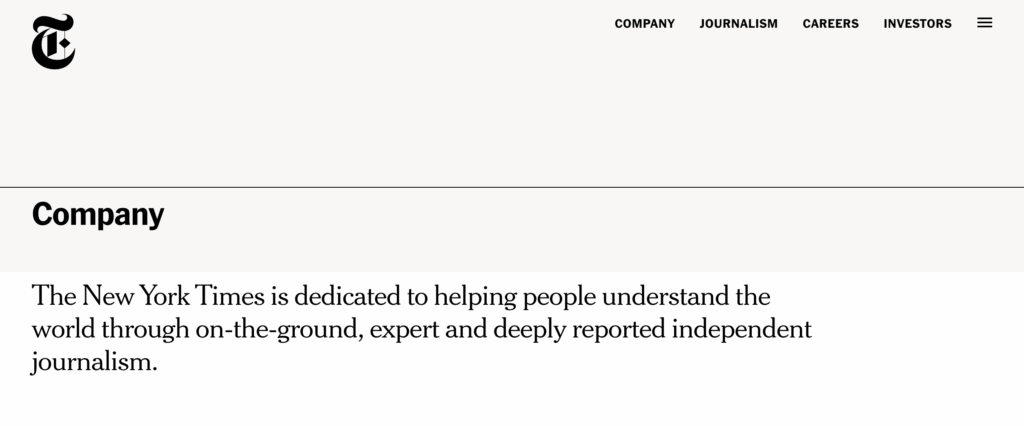
Use your mission as a touchstone when setting long-term goals and making strategic decisions.
Every major initiative should align with and support your mission.
Inform Daily Operations
Encourage employees to consider the mission in their day-to-day work. It should influence how tasks are prioritized and executed.
Shape Company Culture
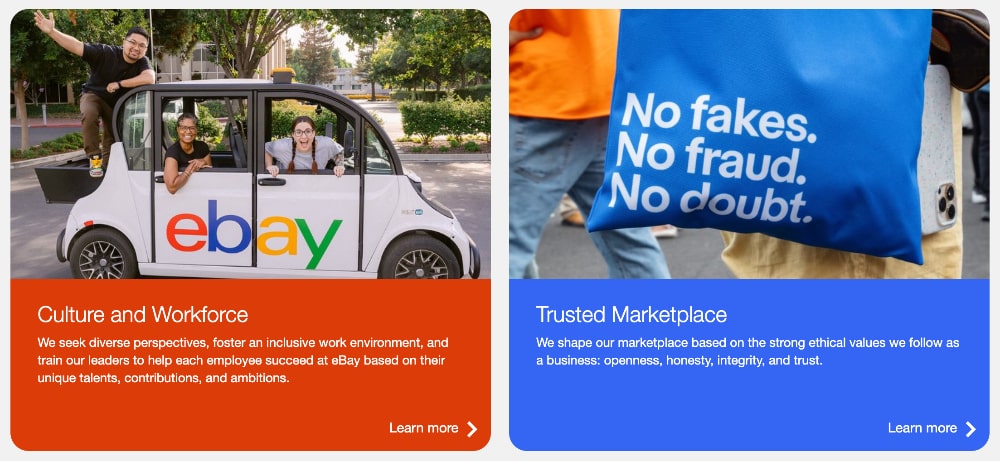
Incorporate your mission into onboarding processes, team meetings, and company events. It should be a living part of your organizational culture.
Drive Marketing and Branding
Let your mission inform your marketing strategies and brand messaging. It should be reflected in how you communicate with customers and the public.
Evaluate Opportunities
When considering new projects, partnerships, or expansions, use your mission as a filter to assess their alignment with your core purpose.
Motivate and Align Employees
Regularly remind staff of the mission and how their roles contribute to it. This can boost motivation and create a sense of shared purpose.
Attract Talent
Feature your mission prominently in job postings and during interviews. It can help attract candidates who resonate with your purpose.
Guide Product Development
Ensure new products or services align with and further your mission. It should inform innovation and development processes.
Inform Corporate Social Responsibility
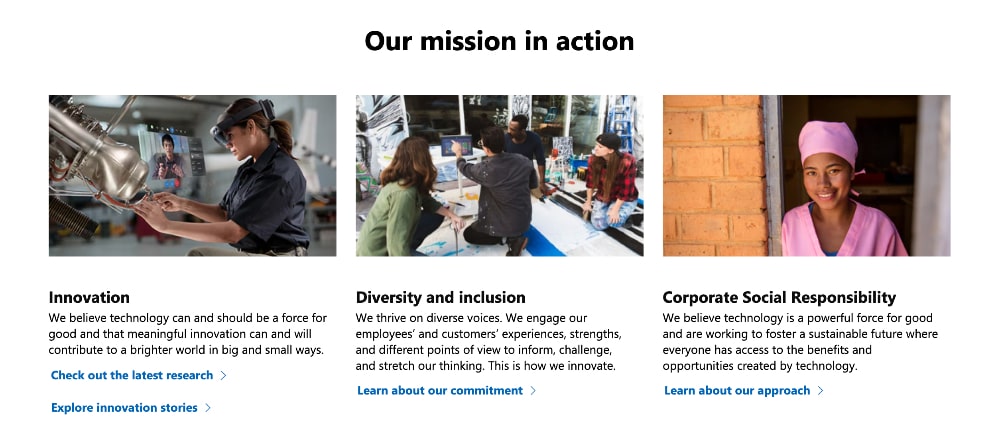
Base your CSR initiatives on your mission to ensure they authentically represent your organization’s values.
Measure Performance
Develop key performance indicators (KPIs) that reflect progress toward fulfilling your mission. These can complement traditional financial metrics.
Communicate with Stakeholders
Use your mission in annual reports, investor communications, and public statements to consistently articulate your purpose.
Remember, your mission statement is not a static document but a living guide for your organization. Regularly revisit and reinforce it to ensure it remains central to your operations and culture.
By actively using your mission statement, you create a more focused, aligned, and purpose-driven organization.
Free Mission Statement Template
Creating a mission statement can be challenging, but using a template can help structure your thoughts and ensure you cover all essential elements.
Here’s a customizable template to guide you in crafting your mission statement:
Template Structure
[Your Organization Name] exists to [core purpose] for [target audience] by [what you do/how you do it] in order to [desired impact/outcome].
Example Using the Template
“XYZ Tech exists to empower small businesses through innovative digital solutions, providing user-friendly tools and personalized support to help them thrive in the digital economy.”
Customization Guide
- Your Organization Name: Start with your company or organization’s name.
- Core Purpose: Articulate the fundamental reason your organization exists. What problem are you solving? What need are you fulfilling?
- Target Audience: Specify who you serve. Be as specific or broad as necessary for your organization.
- What You Do/How You Do It: Describe your primary activities or methods. What makes your approach unique?
- Desired Impact/Outcome: State the ultimate goal or change you aim to achieve. What’s the broader impact of your work?
Tips for Using the Template
- Keep it concise: Aim for one to three sentences.
- Use clear, jargon-free language.
- Ensure each element flows naturally into the next.
- Adjust the order of elements if needed to improve flow.
- Create multiple versions and refine based on feedback.
Remember, this template is a starting point. Feel free to adapt it to best capture your organization’s unique purpose and values.
The most effective mission statements often deviate from strict formulas to authentically represent the organization’s voice and vision.
FAQs About Mission Statements
Conclusion
Coming up with an effective mission statement is a crucial step in defining your organization’s purpose and guiding its future.
A well-written mission statement serves as a north star, aligning your team’s efforts, inspiring stakeholders, and communicating your unique value to the world.
Throughout this guide, we’ve explored the key elements of a strong mission statement, examined many mission statement examples from successful organizations across various industries, and provided practical steps for creating and implementing your own.
Remember that your mission statement should be:
- Clear and concise
- Inspiring and motivational
- Reflective of your core values
- Unique to your organization
- Actionable and relevant to daily operations
Keep in mind that this is an iterative process. Revisit and revise your statement as your organization evolves.
The most effective examples of mission statements are living documents that continue to guide and inspire long after they’re first written.
Ultimately, your mission statement is more than just words on a page—it’s a powerful tool for driving your organization forward.
Additional Resources
To further help you to write your own personal mission statement, we’ve compiled a list of valuable resources.
These resources offer deeper insights, alternative perspectives, additional company mission statement examples, and practical tools to support your mission statement development process.
Books
- “Start with Why: How Great Leaders Inspire Everyone to Take Action” by Simon Sinek
- “Built to Last: Successful Habits of Visionary Companies” by Jim Collins and Jerry I. Porras
Websites and Tools
- MissionStatements.com – Database of mission statement examples from various organizations
- Franklin Covey Mission Statement Builder – Interactive tool for creating personal and organizational mission statements
- Mission Statement Generator – A free tool by ChatSpot to help kickstart your mission statement creation process
Podcasts
- Masters of Scale with Reid Hoffman – Episodes often touch on company missions and visions
- HBR IdeaCast by Harvard Business Review – Frequently discusses strategic topics including mission statements
